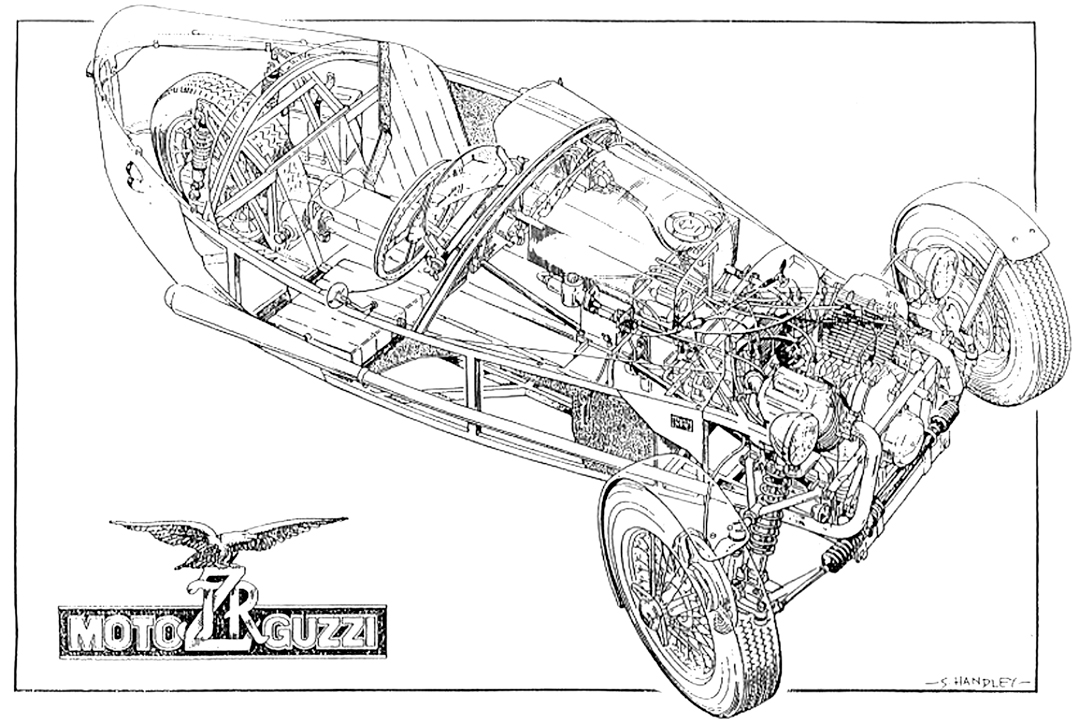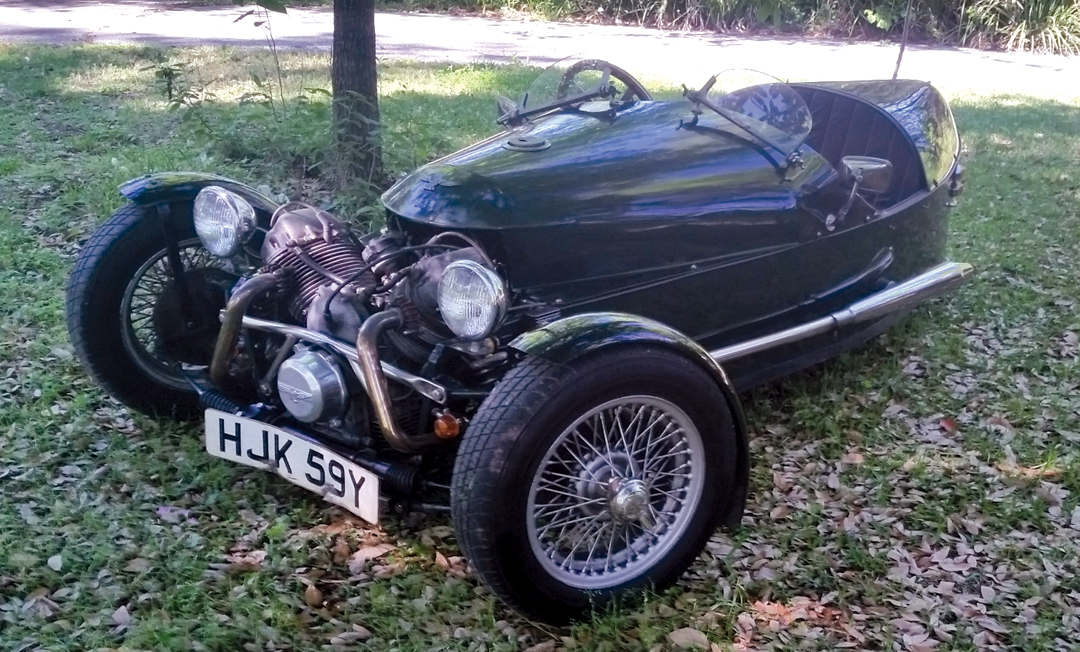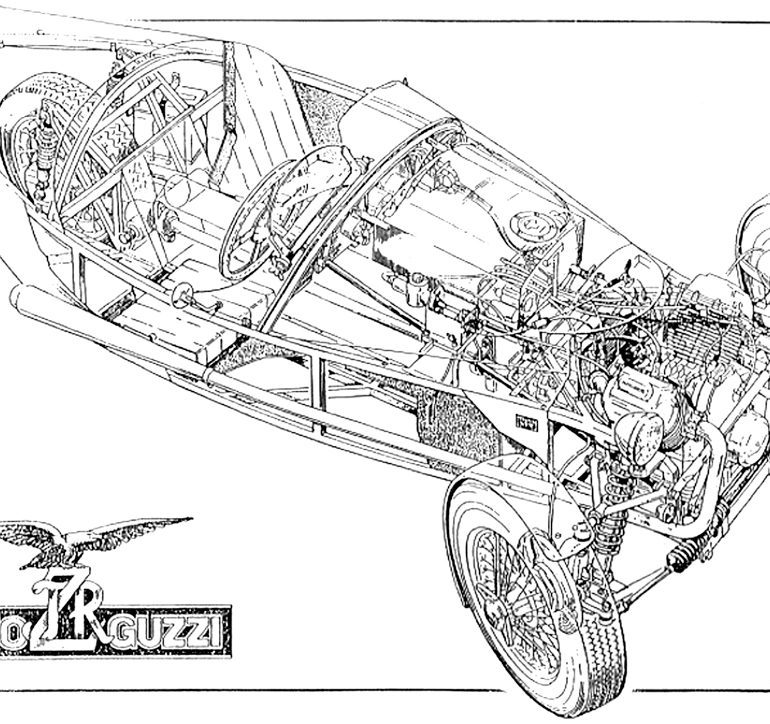“And Now for Something Completely Different.”
This mantra aptly characterized the boldness of Monty Python when it first aired in 1969. Fresh and fantastic; different in the best way possible. In my view, the same can be said of the racing machines and pilots of Great Britain. A bit more on that later. This month’s Hidden Treasure is British, considered fantastic by some, and absolutely different. It was never a racecar but that’s beside the point, as you will soon learn.
John Ziemba of Darwen, Lancashire, England, had an active business restoring three-wheeled Morgans. In 1990, he decided to manufacture his own kit vehicle which he dubbed the JZR (John Ziemba Restorations). To the best knowledge available, less than 500 of these three-wheeler kits were manufactured with the majority of customers being based in the UK. A few examples made their way to the United States and one very nice JZR currently resides in Houston, Texas.
The subject JZR is owned by collector Bill Fester who has a wonderful assemblage of eclectic cars. Fester’s automotive interests are vast and his knowledge of automotive history broad, with one glaring exception. By his own admission, Fester knows almost nothing about motorsports. Ask him who won the Targa Florio in 1970, or the 12 Hours of Sebring in 1975 and you’ll get a blank stare. But, ask Fester about almost any unusual car and he will fire back with robust knowledge.
Of his JZR journey, Fester said, “At some point I became highly focused on three-wheeled vehicles. I decided I wanted to own one and looked at a variety of original Morgans, but thought they might be challenging to keep up with. I seriously considered a BSA three-wheeler, but never got too far down that road. I was also really interested in an obscure vehicle called a Velorex, from Czechoslovakia, but could never find one that I could import without a huge hassle. That left the BMW-powered Scorpions, the Yamaha-powered Skunks, and the JZR, which I viewed as more like a traditional Morgan. In the end, building any kit car from scratch struck me as a daunting task and I sort of shelved the idea altogether.”

Fester continued, “Then one day I received an email from an acquaintance in Seattle indicating a man in Vero Beach, Florida had a fully built JZR for sale. I wasted no time calling and contacted a very pleasant man with a wonderful British accent. His name was Brian and we had a very nice chat. Given that I had owned many small displacement cars with minimal horsepower, I remember asking Brian if the JZR would get up and go. He indicated that he never really opened it up, and I recall being intrigued by the way he said that. He told me that the rear wheel needed to be replaced; at the time I don’t think either of us realized just how challenging that would be. At the end of the discussion, I told Brian I’d have to think about it and would get back to him. After several days, I called Brian back and bought his JZR.”
Fester has researched his JZR but thus far has been unable to uncover the name of the first owner/constructor. His JZR was built with a 1981 twin OHV twin-plug Moto Guzzi V1000 with twin Dellorto carburetors, and produces an honest 70-hp. Front suspension is double A-arm with coilover springs, and the rear suspension is coil swing arms directly from a Moto Guzzi donor bike. Brakes are disc units at all three corners; the fronts are believed to come from an English Ford Sierra, and the rear is from Moto Guzzi. Gearshifts are achieved via a 5-speed Moto Guzzi linear shifter with no provision for reverse.
Fester explained, “I’m not sure if the builder of my JZR had to fabricate the long driveshaft from the rear of the Guzzi box to the donor bike bevel box or whether someone else did that work. On my JZR the entire motorcycle rear suspension was welded to the tube chassis. This arrangement necessitated a spoke wheel for the rear that could be fitted with a car tire, since the original motorbike wheel would be too high. Ziemba had originally used a single firm in the UK to fabricate the special rear wheel.
It took Brian six months to find a U.S. company capable of and willing to make a duplicate, so it was an anxious half-year wait until the JZR arrived in Houston. The steering on my JZR is on the right. With the driveshaft slightly off-center, the driver has the smaller seat and the passenger has only slightly better accommodations. Besides gaining a JZR, Fester found a great new friend in Brian. Fester said, “I’ve worked as a professional recruiter for 25 years and have therefore been exposed to an enormous number of names. For some reason Brian’s name stuck in my head, but it was something not associated with my occupation.
After having that uncomfortable feeling in my head for a long time, I phoned a friend and asked why the man who sold me the JZR seemed so familiar. My friend chuckled and asked if I knew what the Nürburgring was. Of course, I knew it was a racing circuit, but I hadn’t made the connection that my new friend, Brian Redman, was a world famous racecar driver. When it hit me I was totally shocked. It was like buying a second-hand guitar and the seller turns out to be Eric Clapton; except I like cars a lot more than guitars.”
Redman has hosted Fester at his Targa 66 vintage racing events and has introduced him to many racing legends including David Hobbs and Vic Elford. Always ready with an amazing story, Fester says he certainly received much more from Redman than a three-wheeler on this deal. Fester still loves his JZR and the unique British three-wheeler experience it offers. Fester said, “The thing has no roof, no doors and no reverse. I drove my daughter to school in it when she was in third grade. After that the carpool line was never quite the same.”
No. It was completely different.

Do you know of a Hidden Treasure? If so, send your photos and stories to Mark at [email protected]




